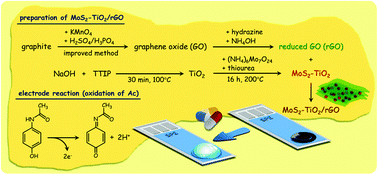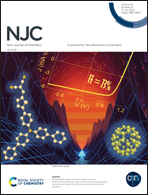Design of a new electrochemical sensing system based on MoS2–TiO2/reduced graphene oxide nanocomposite for the detection of paracetamol†
Abstract
Herein, we designed a new electrochemical sensor (MoS2–TiO2/rGO/SPE) based on a molybdenum disulfide (MoS2)–titanium dioxide (TiO2)/reduced graphene oxide (rGO) nanocomposite-modified screen printed electrode (SPE) for the selective and sensitive detection of paracetamol (acetaminophen, Ac). This design was optimized by examining the effect of the rGO : MoS2–TiO2 ratio, MoS2–TiO2/rGO composite amount on the SPE, and pH of the electrolyte on the current signal of the fabricated sensor towards the oxidation of Ac. MoS2–TiO2/rGO/SPE showed linearity in the range of 0.1 μM to 125 μM with a high sensitivity of 0.4425 μA μM−1. The detection limit (LOD) was found to be 0.046 μM. To test the applicability of MoS2–TiO2/rGO/SPE for practical analysis, a few drops of drug and human urine samples were directly applied on the surface of the fabricated sensor for measuring Ac after dilution of the samples with 0.1 M phosphate buffer solution (pH 7.4). Furthermore, the specificity of MoS2–TiO2/rGO/SPE was evaluated by monitoring the current changes in the presence of possible interferents in biological fluids.



 Please wait while we load your content...
Please wait while we load your content...